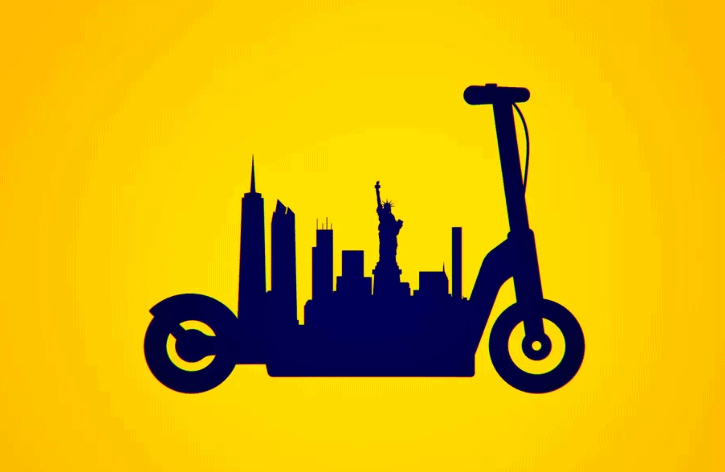
Electric scooters have cropped up en masse in cities across the country from Salt Lake to Washington, DC, but they won’t be hitting the most populous city in the US anytime soon.
On one hand, New York City is a natural fit for these scooter companies, which have been valued at as high as $2 billion in recent months. New York is a city with a booming public transit system that millions take every day, but it’s also filled with gaps. A recent report showed that 24 percent of the city’s subway stations — many located in the Bronx, Brooklyn, and Queens — were inaccessible to many of the city’s residents.
Scooter companies are salivating over the prospects, and sources tell The Verge that conversations between company representatives, lobbyists, and elected officials at the state and city level are already taking place. Scooters will need to navigate a labyrinth of regulatory and infrastructure challenges if they hope to ever gain a foothold.
While there are 12,000 Citi Bikes secured across all five of the city’s boroughs, they often don’t reach the transit-hungry fringes of the city, according to Gil Kazimirov, Lime’s general manager. That’s where scooters come in. New York would be a “tremendous scooter city because you’ve got a pretty good public transit infrastructure, but you still have a ton of gaps, particularly in the outer boroughs,” Kazimirov said.
In many cities where shared scooters have already taken hold, they act like an extension to connect with public transit hubs and fill in the gaps where they fall short. They could easily do the same in New York City, which is pretty flat overall, making for easy scooting around.
Its residents have a lot to gain by using these vehicles, according to Joseph Cutrufo, a spokesperson for the transit advocacy group Transportation Alternatives. New York is the third most congested city in the world. This is, in part, due to curbside games of Tetris between the thousands of vehicles driving through the streets, battling against those that are double or triple parked throughout the city. This congestion is an environmental blight as well as a drag on commuters’ schedules, and it costs the city billions of dollars annually.
“It’s a borderline untenable system,” Cutrufo said, speaking of the city’s transportation network. “But, you know, we’ve grown used to it. And though maybe we’re a little fatigued by it, we just accept the status quo as it is.”
In many ways, the city is designed for cars and only cars. As Cutrufo pointed out, the city’s dedicated almost every foot of curbside space to long-term parking — a lot of it free or low-cost. Part of this is undoubtedly due to the city’s zoning laws, which have requirements baked in that obligate the creation of curbside parking spaces for each new building. And without curbs or designated parking, the dockless scooter system, for all of its benefits, falls apart. Scooters would get dumped onto sidewalks and block pedestrian traffic, he said.
This is happening right now in other cities where electric scooters have gained a foothold. In San Francisco, for example, scooters have been parked in the middle of sidewalks, left to lounge atop trash cans, and tossed into the bay. Scooter users have also been caught behaving badly in other cities. Now, regulators are reacting the way San Francisco’s local government did: banning the scooters until a permitting process is in place.
“When you introduce dockless bike share, or dockless scooter share but don’t include a place for them to park, you’re kind of doing it on the cheap, politically,” Cutrufo said. “You’re saying, ‘Look at all these bikes and scooters. Look at us doing alternative transportation.’ But you’re just trying to shoehorn them into a car-focused system. That’s not really sustainable.”
In the past few months, scooter companies have successfully grown their business nationwide. Some cities, like Milwaukee, have opted to put new regulations in place, rather than fight the impending scooter onslaught. Other cities, like Nashville, Denver, and Minneapolis, stood by helplessly as hundreds of scooters were dropped onto their streets.
It’s a messy system, but also entirely legal. Because scooter-sharing programs are still very new, cities have been caught flatfooted. Nashville officials threatened to take action against the scooter companies when enough citizens complained of sidewalk obstructions or, in some cases, were critically injured.
The scooters in these smaller cities endured because transportation and mobility concerns tend to take the back burner to economic, education, and housing issues, says Jordan Levine, a spokesperson for electric bike service Ofo. A situation like this would never happen in New York. For all of its faults, he said, New York City’s Department of Transportation is one of the largest and most sophisticated in the world, and New York state is perfectly clear about which electric vehicles are legal (or illegal) to ride in the city.
In the state’s eyes, the electric boost means scooters are motor vehicles, meaning they must be registered the same way someone would register a motorcycle or a moped. But there’s no process in place to register an electric scooter, leaving them in regulatory purgatory. A visit to the New York state’s DMV website reveals that “motorized scooters” can’t be ridden anywhere in the state.
The city has faced criticism for police crackdowns on electric-powered bicycles, with advocates arguing that they disproportionately hurt the immigrant delivery workers who use them to travel faster and longer than they could on traditional pedal bikes. One city councilmember, Rafael Espinal, criticized the city’s approach in an op-ed in the New York Daily News: “If e-bike riders follow the same laws of the road as do nonelectric-bike riders, they should have the exact same access to our streets.”
Espinal voiced support for a state bill that would include electric-assisted bicycles in the definition of “bicycle,” and thereby permit their use. Legalizing e-bikes could open the door wide enough to allow scooters through, too.
The scooter companies see opportunities — and dollar signs — in a city as large and dense as New York. A source with knowledge of the scooter companies’ plans said that they are aggressively exploring ways to change the law to allow for scooter sharing. “They’re coming,” the source said. “Whether it takes a change in city law or state law, it’s coming.”
If New York state does come around to scooters, the resulting laws might lean on the stringent side, Levine said. Expect there to be a requirement of a driver’s license and helmet, he said. And, depending on how the DOT interprets the law, it could possibly even require a motorcycle license. These decisions will determine where scooters belong: on sidewalks, in bike lanes, or streets, Levine said.
“I think that’s what the city’s really worried about,” he said. “Are bike riders going to get upset if scooters are zipping by them in bike lanes? Are these scooters going to be able to operate in traffic in New York City streets? Are they going to hurt pedestrians if they’re on sidewalks?”
The state Senate is starting to wrestle with these issues. State Sen. Martin Golden recently introduced “The Innovative Transportation Act of 2018,” a bill that intends to make scooters legal throughout New York. Garld Kasser, the chief of staff for Golden, didn’t respond to four emailed attempts to nail down which other states the new framework would be based on.
It turns out that other city politicians are reticent to talk about these issues as well. Genevieve Morton, the communications director who represents councilmember Brad Lander, declined to comment on the issue, as did Jacob Tugendrajch, who represents Council Speaker Corey Johnson. Stephanie Miliano, who represents councilmember Ydanis Rodriguez, didn’t respond to multiple emails, and attempts to reach these councilmembers directly on the phone or via email were also ignored.
Until that gets squared away, the city’s eco-conscious commuters will have to make do with bikes rather than electric scooters. In April, New York City Mayor Bill de Blasio announced that pedal-assist electric-bikes would be allowed to operate in the city, after previously promising to crack down on the people illegally riding them and seizing hundreds of e-bikes in the process. On July 13th, he even teamed up with the DOT to kick off a dockless bike-share pilot in the Rockaway Peninsula.
The move suggests that similar rollbacks of current e-scooter laws could one day allow these companies a foothold.
























